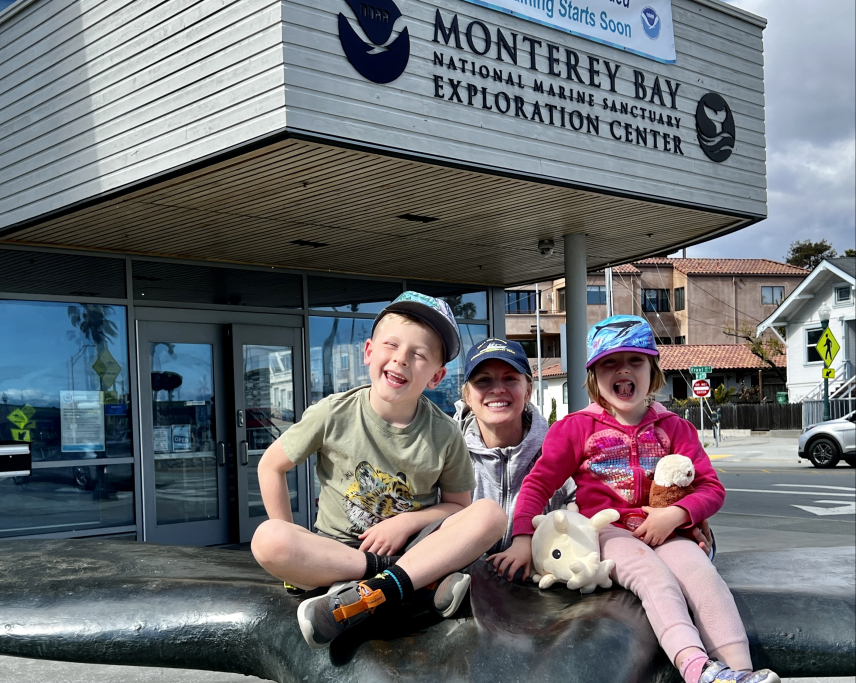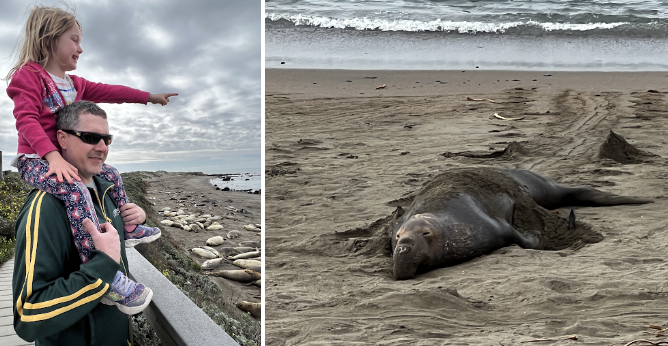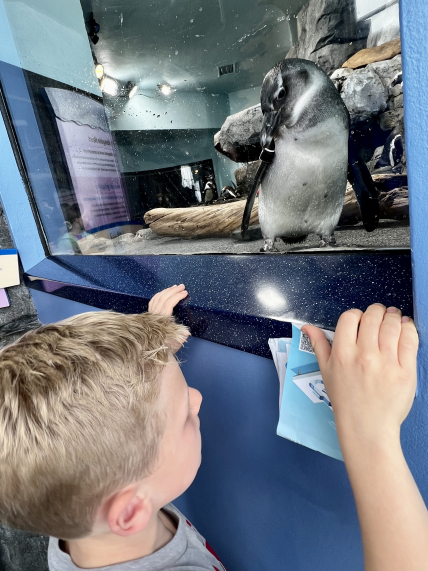"Although I was on vacation from my job at NOAA, I was 'on the job' learning all about NOAA’s mission within my home state."
During her children’s spring break, Nicole Fernandes and her family spent time exploring the diverse habitats along the central coast of California. Currently on a temporary assignment to NOAA’s Office of Education from her normal job as a policy and program analyst within the National Ocean Service’s Policy Office, Nicole wanted to share these unique places and the wondrous organisms that live there with her children as well as what NOAA and its partners are doing to conserve them. Read about their NOAA adventure below!

When my family and I set off from our home near Long Beach, California, for a recent spring break adventure, we did not anticipate encountering NOAA nearly every place we went. Although I was on vacation from my job at NOAA, I was “on the job” learning all about NOAA’s mission within my home state. Several stops along the coast enabled us to experience the many ways NOAA and our partners protect endangered species, promote recreation, and provide educational opportunities about the state’s natural and cultural resources.
Sanctuaries, satellites, and sea stars
As we drove north up the coast, we enjoyed beautiful views of the Channel Islands National Marine Sanctuary and the proposed Chumash Heritage National Marine Sanctuary. We also passed Vandenberg Space Force Base where last November I was fortunate to witness the NOAA National Environmental Satellite, Data, and Information Service’s Joint Polar Satellite System-2 launch. The satellite is providing a continuous stream of data used for weather forecasting and monitoring climate change.
Our first stop in Cambria, California, consisted of a handful of hikes along coastal public trails. As we ambled along the bluffs, we caught sight of California gray whales, harbor seals, and red-tailed hawks. We observed kelp forests from the cliffs and discussed how they provide important habitat for Pacific Coast groundfish and other species. We also discussed that our ability to play along the beach and observe tidepools filled with sea stars is thanks in part to California’s participation in NOAA’s Coastal Zone Management Program, which promotes public access to coasts for recreation under the Coastal Zone Management Act.
Northern elephant seals
Traveling north, we stopped in San Simeon, California, home to the largest land-based rookery of northern elephant seals in the world. Northern elephant seals were once thought to be extinct due to commercial sealing in the 1800s. The population we visited are derived from a small colony that survived in Mexico and steadily increased in the early 1900s. Like all marine mammals, northern elephant seals are protected by the Marine Mammal Protection Act. Our family reveled in the snorts and calls of the beached seals and their characteristic elephant-like noses.

Monterey Bay Aquarium
As we continued driving north, we encountered one of the many atmospheric rivers — long, narrow corridors that transport vast amounts of water vapor in the atmosphere — that California has experienced over the last several months. An infographic on atmospheric rivers from the NOAA National Weather Service that we found in a central California newspaper was part of our bedtime reading during our first night in Monterey. While it stormed outside the next day, we visited the Monterey Bay Aquarium, a member of the Coastal Ecosystem Learning Centers network. NOAA partners with the aquarium on a range of activities, such as supporting harmful algal bloom research and reducing marine debris in the Monterey Bay National Marine Sanctuary. During our visit, we especially enjoyed encounters with African penguins and luminescent jellyfish and the daily feeding for Pacific sardines, hammerhead sharks, and tuna. As we ate lunch in the Aquarium’s dining room, we viewed frolicking dolphins and southern sea otters in the coastal waters outside.

Elkhorn Slough National Estuarine Research Reserve
The highlight of the trip was kayaking in the Elkhorn Slough National Estuarine Research Reserve offsite link (NERR), one of 30 coastal sites nationwide designated to protect estuaries. NOAA maintains partnerships with state, academic, and other entities through the National Estuarine Research Reserve System, including the Elkhorn Slough NERR which is managed by the California Department of Fish and Wildlife. During our hour-long kayak tour, southern sea otters rolled in the water 10 feet away, while harbor seals and several shore birds lounged on the banks. It was magical being so close to several iconic species!
Monterey Bay National Marine Sanctuary
Our last NOAA stop before heading home to southern California was the Monterey Bay National Marine Sanctuary Exploration Center in Santa Cruz. Our children enjoyed several interactive exhibits, including playing in a pretend tidepool and controlling an underwater remotely operated vehicle like those supported by NOAA’s Ocean Exploration program. During the visit, our seven-year son Xavier pledged to “keep doing beach clean-ups” to protect the national marine sanctuaries along the California coast.
Our coastal vacation was enriched by the many resources NOAA provides for learning about and experiencing California’s unique natural and cultural resources. Our family loved witnessing the wildlife up close that NOAA helps protect and recreating along the coast we’ve come to love even more in our home state. Even while taking time away from work, I was grateful to be immersed in NOAA’s expansive and meaningful mission!

